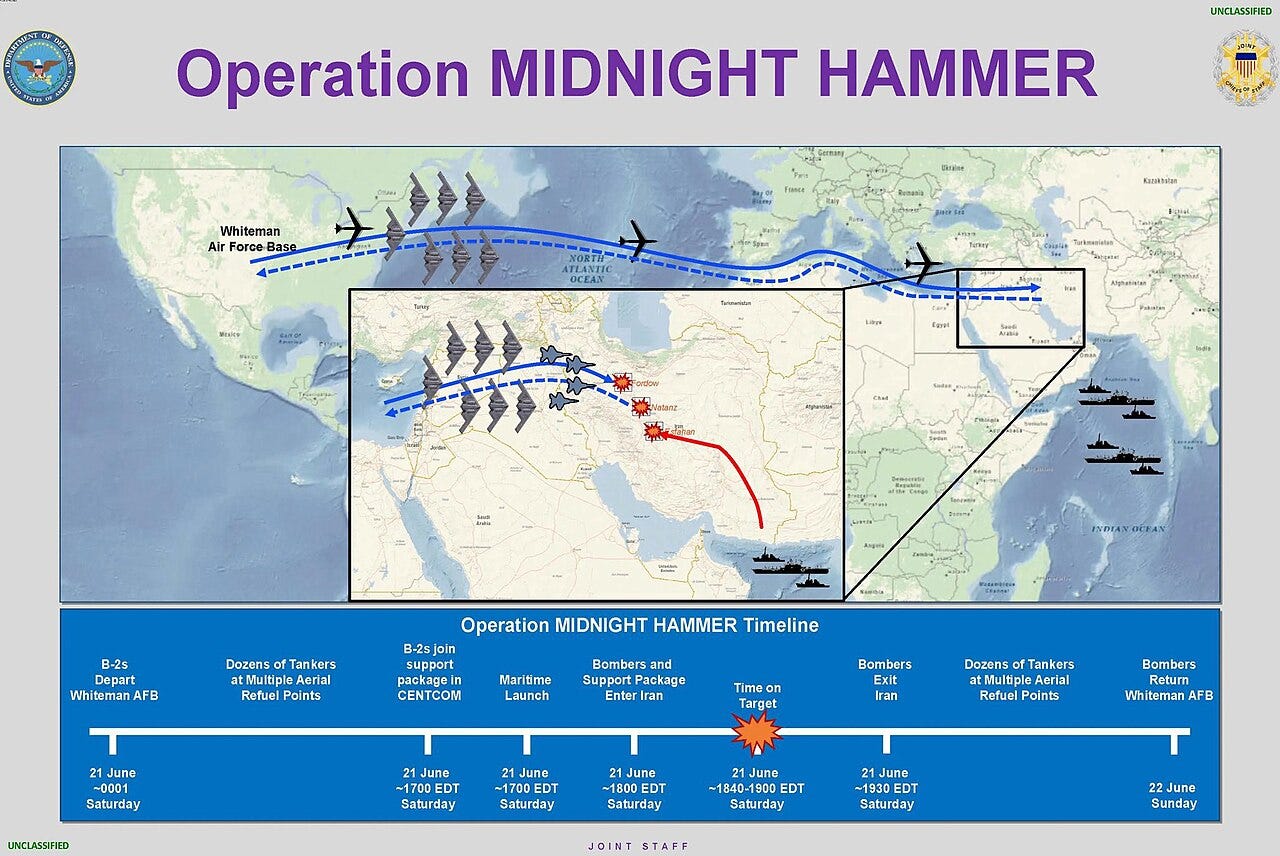Images Indicate AGM-158 JASSM Cruise Missile Use Against Ansarallah—and Perhaps Iran
🇮🇷 🇮🇱 🇯🇴 🇺🇸 🇾🇪 Newly Released Images Offer A Glimpse Into Scale, Cost Of U.S. Operations Against Ansarallah in Yemen
Key points:
Newly released images indicate that U.S. Air Force F-15E strike fighters forward-deployed in Jordan between October 2024 and July 2025 undertook both air-to-air sorties—including AGR-20 (APKWS) launches—and air-to-ground sorties—including AGM-158 JASSM land-attack cruise missile launches.
While U.S. Air Force employment of AGM-158 JASSM family land-attack cruise missiles against Ansarallah in Yemen (Operation Rough Rider, March-May 2025) has been previously reported, newly released images strongly suggest the involvement of U.S. Air Force F-15E strike fighters forward deployed to Jordan in the employment of AGM-158 JASSM family cruise missiles against Ansarallah.
Although the AGM-158 JASSM launch markings may also reflect employment against Iran in Operation Midnight Hammer (22 June 2025), available information suggests that U.S. Air Force F-15E operating out of Muwaffaq as-Salti Air Base in Jordan actively participated in Operation Rough Rider against Ansarallah in Yemen. The key pieces of information supporting this hypothesis are images showing three F-15E fighters with six or more markings indicative of AGM-158 JASSM family launches in a context in which the F-15E can ordinarily carry two such cruise missiles and has been experimentally loaded with just five such cruise missiles. This is indicative of multiple AGM-158 JASSM launch sorties for the relevant F-15E strike fighters, a dynamic that suggests that the AGM-158 JASSM family were primarily, if not exclusively, employed by said F-15E strike fighters during the multi-month Operation Rough Rider against Ansarallah in Yemen as opposed to the single-day Operation Midnight Hammer against Iran.
Available information does not, however, exclude the potentiality of parallel AGM-158 JASSM family cruise missile employment against Iran in Operation Midnight Hammer. These are not mutually exclusive hypotheses, and further information is required.
The Aviationist has released illuminating images captured by Stewart Jack of U.S. Air Force F-15E strike fighters from the 366th Fighter Wing—garrisoned at Mountain Home Air Base, Idaho—returning to the continental United States by way of Mildenhall Air Base in the United Kingdom. These F-15E fighters were forward-deployed to the Central Command (CENTCOM) area of responsibility in October 2024, during which these aircraft are understood to have been operating from Jordan's Muwaffaq as-Salti Air Base near al-Azraq. The newly released images indicate the large-scale expenditure of various munitions during a deployment that began in October 2024 and concluded in July 2025. This includes the employment of AGR-20 (APKWS) semi-active laser homing guided rockets, presumably in an air-to-air role against the likes of Iranian Shahed-136 propeller-driven strike drones and similar. The images also indicate that just eleven U.S. Air Force F-15E strike fighters from the 366th Fighter Wing collectively launched no fewer than forty-four AGM-158 JASSM family air-launched cruise missiles during this nine-month-long deployment.
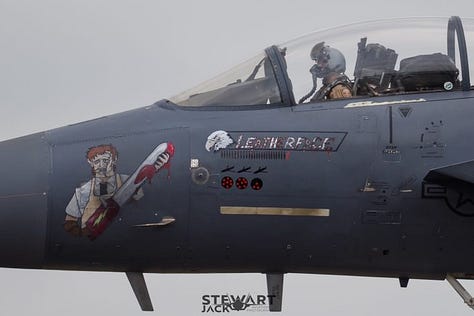
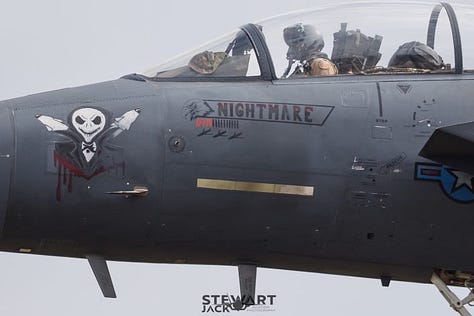
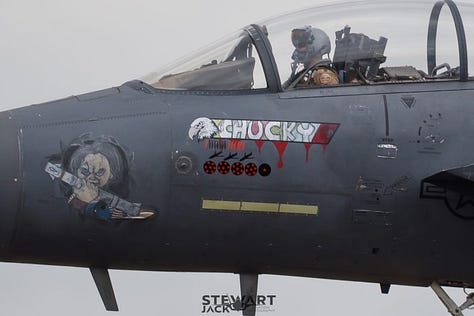
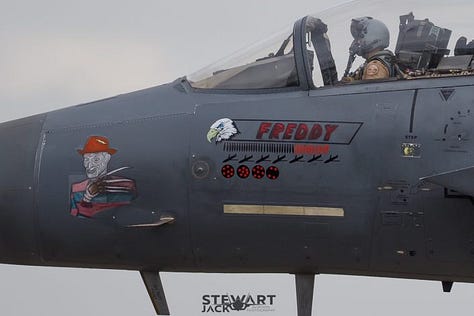
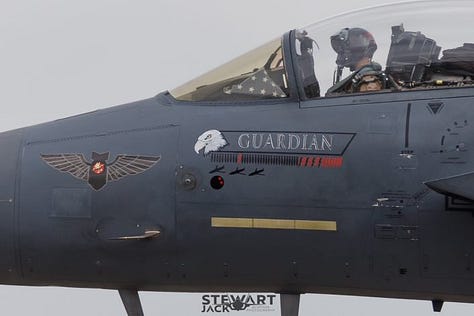
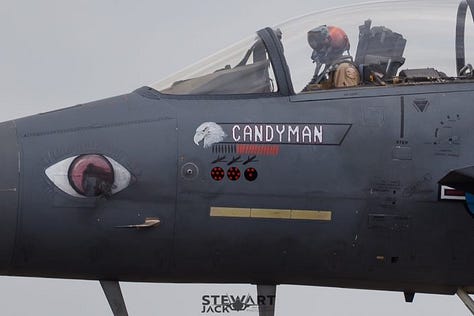
The above set of six images indicates the employment of twenty-two AGM-158 JASSM family air-launched land-attack cruise missiles. Note that one of the aircraft—87-0173 “Freddy”—has markings which indicate the employment of seven such air-launched cruise missiles.
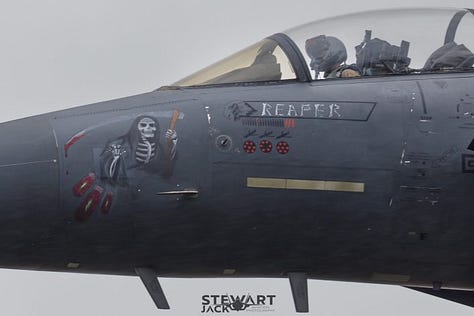
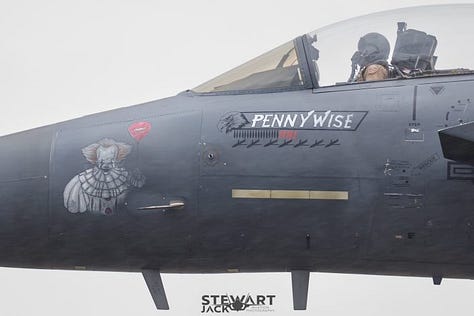
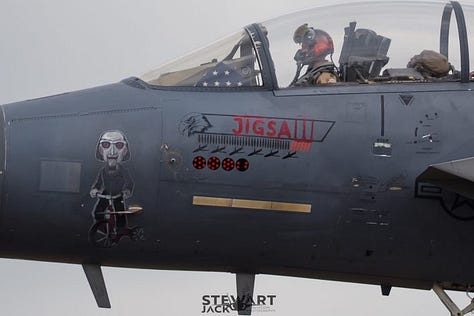
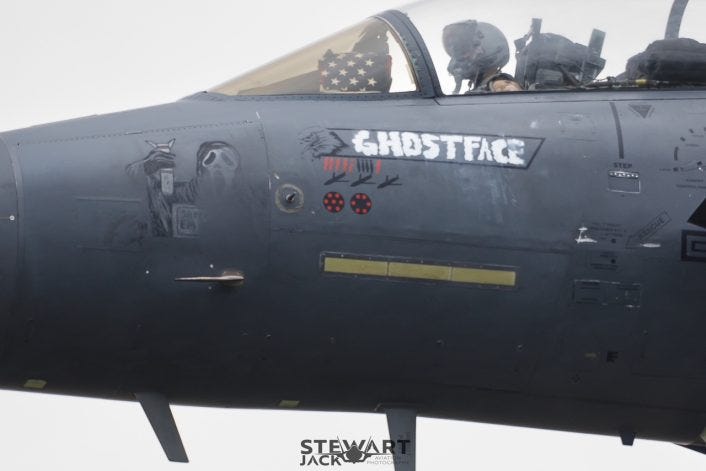
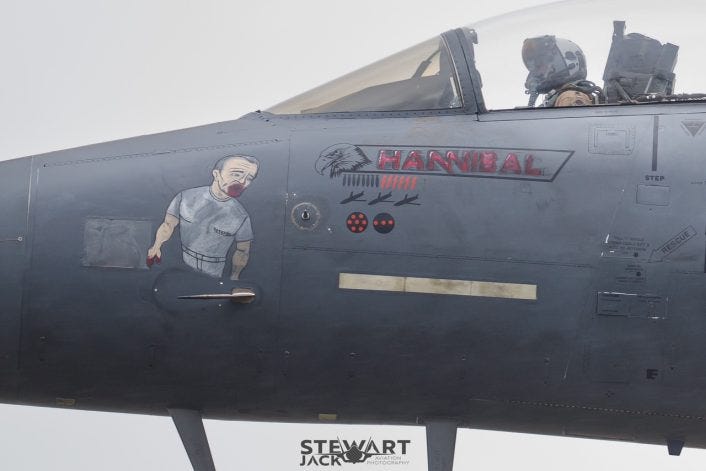
The above set of five images also indicates the employment of twenty-two additional AGM-158 JASSM air-launched land-attack cruise missiles. Note that one of the aircraft—87-182 “Pennywise”—has markings which indicate the employment of seven such air-launched cruise missiles.
Collectively, these images indicate that these eleven F-15E aircraft from the U.S. Air Force’s 366th Fighter Wing launched a total of forty-four AGM-158 JASSM family air-launched land-attack cruise missiles between October 2024 and July 2025. It is important to note that one additional hitherto forward-deployed F-15E has been pictured en route to the continental United States without any AGM-158 JASSM employment markings on the fuselage.
These F-15E strike fighters from the U.S. Air Force’s 366th Fighter Wing arrived in Jordan after Iran's Operation True Promise II on 1 October 2024, which notably exclusively entailed the employment of ballistic missiles and not (also) cruise missiles and strike drones, as was the case with Iran's 13 April 2024 Operation True Promise I. While Israel retaliated against Iran with Operation Days of Repentance on 26 October 2024, the U.S. is understood to have not been involved in the Israeli strikes against Iran in that single-day operation. Hence, there was no scope for the employment of AGM-158 JASSM by these U.S. Air Force F-15E strike fighters at the time.
Did These F-15E Strike Fighters Launch AGM-158 JASSM Cruise Missiles Against Iran?
Since the release of these images of F-15E strike fighters of the 366th Fighter Wing with markings returning to the continental United States, there has been some speculation that these aircraft were involved in Operation Midnight Hammer, which is to say the United States' single-day targeting of Iranian nuclear facilities—and presumably nearby Iranian air defence capabilities—on 22 June 2025. While the employment of AGM-158 JASSM in Operation Midnight is plausible and cannot be ruled out, two of the newly released images, however, suggest that these AGM-158 JASSM expenditures could not have exclusively taken place on 22 June 2025 as part of Operation Midnight Hammer.
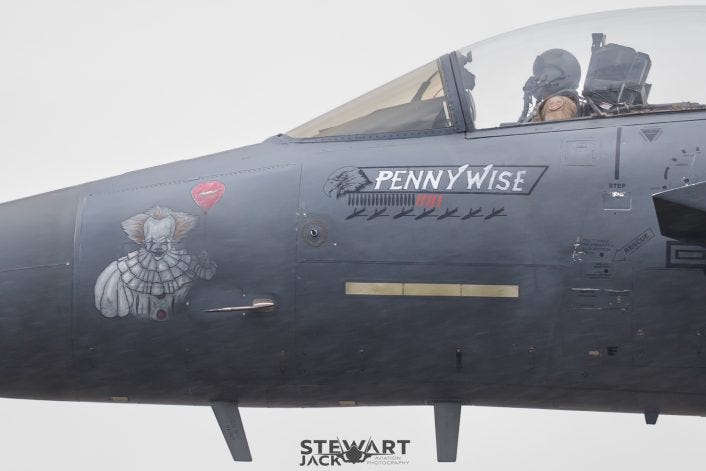
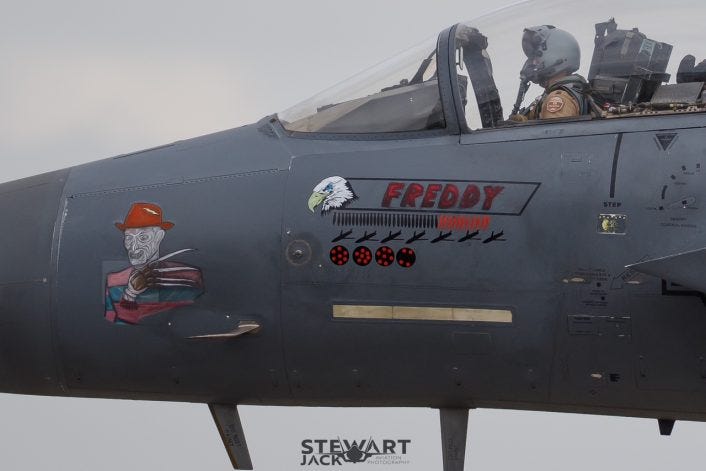
Two of the F-15E strike fighters—87-182 “Pennywise” and 87-0173 “Freddy”—have markings indicating the employment of seven AGM-158 JASSM family air-launched cruise missiles per aircraft. This strongly suggests that the 366th Fighter Wing’s forward-deployed F-15E strike fighters did not, or at least did not exclusively, employ AGM-158 JASSM family air-launched cruise missiles on 22 June 2025 against Iran as part of Operation Midnight Hammer.
Although it is a heavy twin-engine strike fighter, the F-15E was previously limited to carrying just two AGM-158 JASSM family air-launched land-attack cruise missiles per aircraft sortie—the AGM-158 is a very large and quite heavy munition. Is it plausible for these two F-15E strike fighters to have taken off from Muwaffaq as-Salti Air Base in Jordan on 22 June 2025, launched two—perhaps more—AGM-158 JASSM cruise missiles against Iran, landed to rearm, taken off to launch additional AGM-158, and repeated this sequence up to two more times? It bears emphasis that another of the eleven F-15E strike fighters captured in the recently released images has six AGM-158 JASSM family launch markings, while the remaining eight—excluding the one airframe without any such markings—have three launch markings each indicating AGM-158 JASSM family employment. Supposing that these eleven F-15E strike fighters with AGM-158 JASSM family launch markings were not only involved in Operation Midnight Hammer but launched AGM-158 JASSM family cruise missiles against Iran while restricted to carrying two such missiles per sortie, all eleven F-15E strike fighters would have had to undertake two or more sorties during the single-day—seemingly several-hours long—Operation Midnight Hammer on 22 June 2025.
While it is plausible in principle, it bears emphasis that the AGM-158 JASSM is a subsonic cruise missile design—it has a similar time to target as all the other aircraft in the strike package, including the subsonic B-2 bombers—even supersonic capable fighter aircraft almost always remain subsonic. There simply wasn’t much time in the single-day Operation Midnight Hammer for F-15E strike fighters operating out of Jordan to undertake multiple subsonic cruise missile launch sorties unless there is a fundamental miscommunication of the temporal scope and sequencing of Operation Midnight Hammer in the public sphere.
While F-15E strike aircraft were previously limited to carrying just two AGM-158 JASSM family air-launched cruise missiles per sortie, in May 2021, the U.S. Air Force disclosed Project Strike Rodeo, an experimental attempt aimed at allowing each F-15E strike fighter to carry no fewer than 5x AGM-158 JASSM. In so doing, a formation of F-15Es could deliver a "bomber's worth" of cruise missiles. It bears emphasis that each F-15E cruise missile carrier in such a notional formation will be very heavily laden and likely require extensive support from aerial refuelling aircraft to have anything but a minimal operating radius.
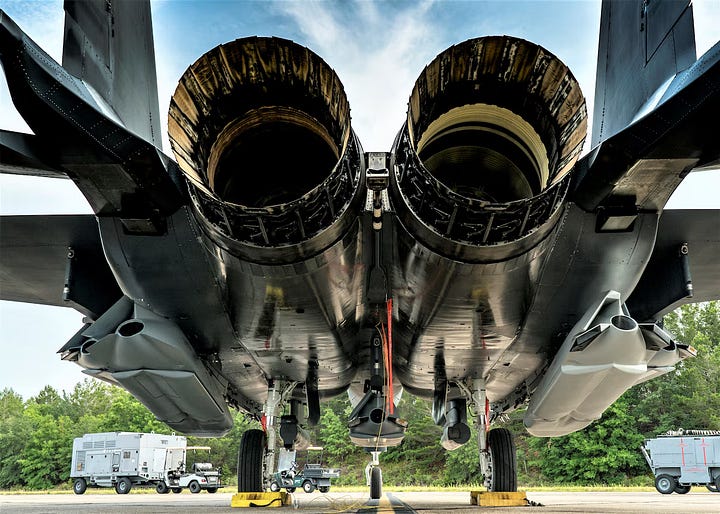
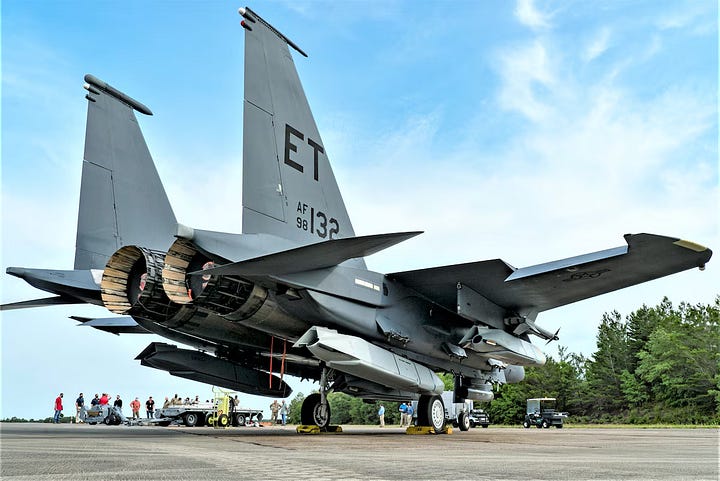
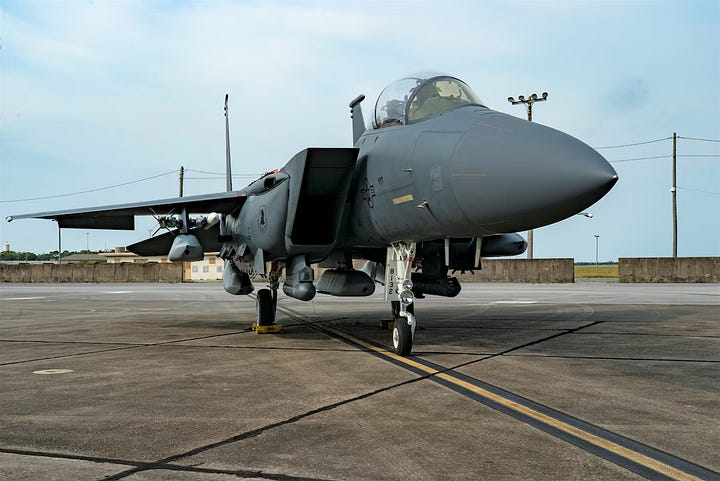
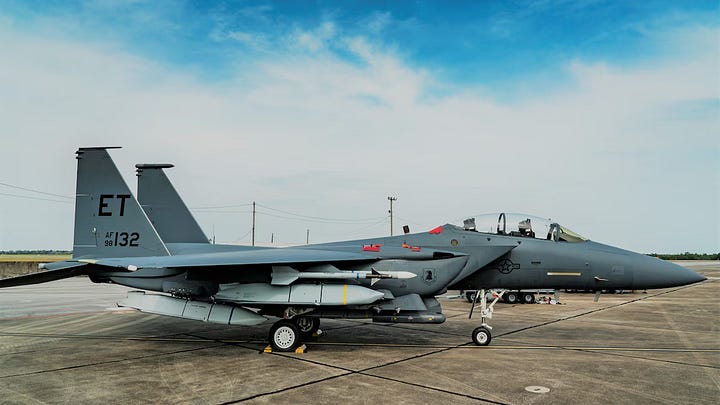
The results of Project Strike Rodeo and any other potentially similar efforts are not public knowledge as of this writing, and U.S. Air Force F-15E—and perhaps F-15EX—may or may not be currently capable of carrying more than two AGM-158 JASSM family cruise missiles per aircraft sortie. In any event, Project Strike Rodeo only aimed to load up to five AGM-158 JASSM family cruise missiles per aircraft, and the publicly released images strongly indicate that there was little real estate left for the aircraft to carry any more of these large and quite heavy cruise missiles. The recently released images show that two of the relevant F-15E strike fighters—87-182 “Pennywise” and 87-0173 “Freddy”—have markings indicating the employment of no fewer than seven AGM-158 JASSM family air-launched cruise missiles by each of these aircraft. These two particular F-15E strike fighters are, as such, very unlikely to have each launched seven AGM-158 JASSM cruise missiles on 22 June 2025 against Iran in Operation Midnight Hammer.
An Alternative Explanation: Most—Perhaps All—Of These Forty-Four AGM-158 JASSM Cruise Missiles Were Launched Against Ansarallah in Yemen As Part of Operation Rough Rider
While available information does not exclude the potentiality of AGM-158 JASSM family cruise missile employment against Iran in Operation Midnight Hammer—the U.S. military has officially disclosed that UGM-109 Tomahawk land-attack cruise missiles were employed against Iran—a more plausible alternative explanation is that most—perhaps all—of these forty-four AGM-158 JASSM cruise missiles were launched against Ansarallah in Yemen as part of Operation Rough Rider (March-May 2025). Although public reporting suggested that the U.S. Navy was primarily involved in air-to-ground operations and the employment of standoff munitions, including cruise missiles, against Ansarallah prior to the forward-deployment of U.S. Air Force bomber aircraft to Diego Garcia, on 4 April 2025, CNN reported that the United States had already employed AGM-158 JASSM family air-launched land-attack cruise missiles against Ansarallah.
The CNN reporting amounted to a surprising development at the time, given that it made little sense for the U.S. Air Force to forward-deploy B-2 bombers to Diego Garcia simply to launch AGM-158 JASSM family cruise missiles against Ansarallah. There were also no reports of the forward-deployment of B-1 bombers and, more importantly, there was no indication that the Gulf Arab states had any interest in actively participating in Operation Rough Rider alongside the U.S. military. There was, in other words, no reason to think that U.S. Air Force fighter aircraft operating from airbases in the Gulf Arab states—or U.S. Air Force fighter aircraft operating out of Camp Lemonnier in Djibouti—were launching AGM-158 JASSM family cruise missiles against Ansarallah.
Given the fact that the U.S. Navy was the lead service in Operation Rough Rider, it was tempting to think that the U.S. Navy was launching AGM-158 JASSM family cruise missiles against Ansarallah. The U.S. Navy had, after all, declared an objective to integrate the AGM-158 JASSM on its carrier-borne F/A-18E/F fighter aircraft in 2022. The language found in Fiscal Year 2025 budgetary documents, however, suggested that the integration of the AGM-158 JASSM, namely the AGM-158B JASSM-ER, may not have been completed by April 2025. While a possibility existed that the U.S. Navy was launching AGM-158 JASSM family cruise missiles from the F/A-18E/F fighters hosted by the USS Harry S. Truman (Carrier Strike Group 8) in the Red Sea following an unannounced emergency or expedited integration effort, there was no information to confirm this. When the USS Carl Vinson (Carrier Strike Group 1) began to operate in support of Operation Rough Rider from the Arabian Sea, it contributed one F-35C squadron—the USS Truman was deployed with four embarked F/A-18E/F squadrons. The AGM-158 JASSM is, however, too large for internal carriage by the F-35C and is not reported to have been integrated onto the carrier-borne aircraft for use as an externally carried munition.
The newly released images strongly suggest that U.S. Air Force F-15E fighters of the 366th Fighter Wing forward-deployed to Muwaffaq as-Salti Air Base in Jordan undertook AGM-158 JASSM family cruise missile launches against Ansarallah in Yemen—perhaps alongside other U.S. Air Force aircraft and possibly even U.S. Navy aircraft. While the U.S. Air Force initially forward-deployed these aircraft to Jordan with the primary objective of intercepting Iranian strike drones and cruise missiles —and similar Iranian-supplied strike munitions launched by Iran’s non-state allies in Iraq—en route to Israel—as well as U.S. bases in Syria, Iraq, and Jordan—the mission of the 366th Fighter Wing’s forward-deployed F-15E fighters seemingly expanded to include cruise missile strikes against Ansarallah in Yemen as part of Operation Rough Rider, something that was not public knowledge prior to the availability of the recently released images of said F-15E fighters with markings en route back to the continental United States.
Supposing that this non-mutually exclusive interpretation is correct—AGM-158 JASSM launches by the F-15E fighters of the 366th Fighter Wing against Ansarallah as part of Operation Rough Rider do not preclude AGM-158 JASSM launches by said aircraft, let alone other U.S. Air Force aircraft, against Iran in Operation Midnight Hammer—the F-15E with markings captured in recently released images presumably took off from Muwaffaq as-Salti Air Base and transited over the Gulf of Aqaba to launch AGM-158 JASSM family cruise missiles over the Red Sea. It bears emphasis that some 1550 kilometers separate the Straits of Tiran from Northern Yemen—assuming flight paths that avoid Saudi airspace, which is to say that these were likely fairly long-range/duration strike sorties that required support from aerial refuelling aircraft to strike targets in the vicinity of Sana’a and elsewhere in Yemen’s highlands. Given the paucity of currently available information, it is not possible to determine how many of the forty-four AGM-158 JASSM family cruise missiles launched by just eleven U.S. Air Force F-15E strike fighters from the 366th Fighter Wing were employed against Ansarallah in Yemen as part of Operation Rider, but the newly released images of said aircraft strongly suggest that these cruise missiles were unlikely to have been exclusively employed—if at all—against Iran in Operation Midnight Hammer.





